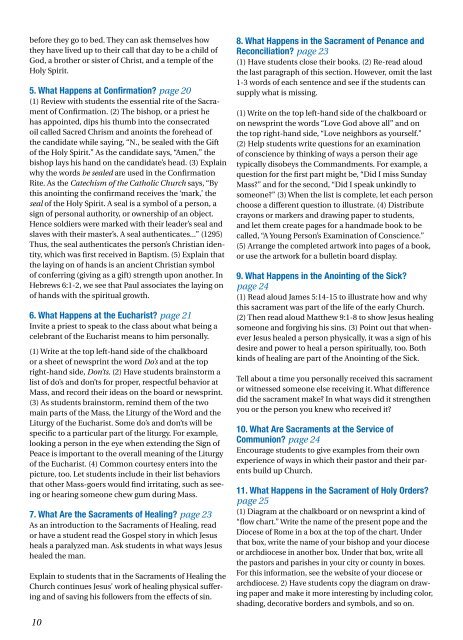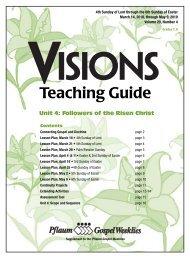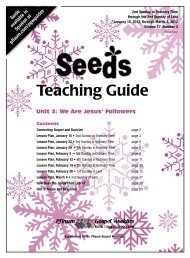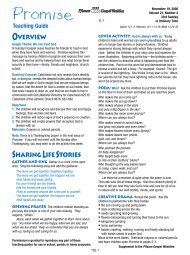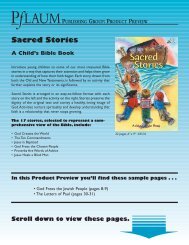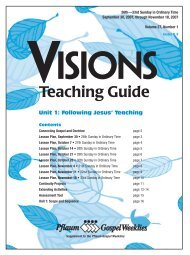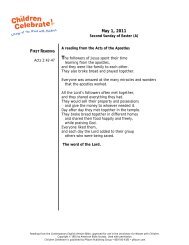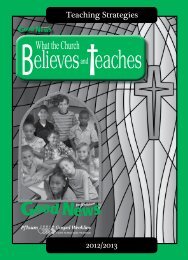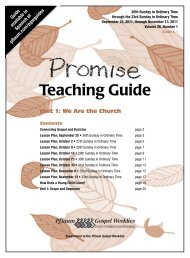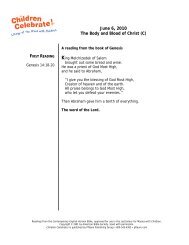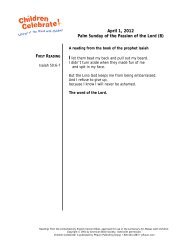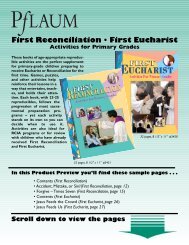Venture - Pflaum Gospel Weeklies
Venture - Pflaum Gospel Weeklies
Venture - Pflaum Gospel Weeklies
Create successful ePaper yourself
Turn your PDF publications into a flip-book with our unique Google optimized e-Paper software.
efore they go to bed. They can ask themselves how<br />
they have lived up to their call that day to be a child of<br />
God, a brother or sister of Christ, and a temple of the<br />
Holy Spirit.<br />
5. What Happens at Confirmation? page 20<br />
(1) Review with students the essential rite of the Sacrament<br />
of Confirmation. (2) The bishop, or a priest he<br />
has appointed, dips his thumb into the consecrated<br />
oil called Sacred Chrism and anoints the forehead of<br />
the candidate while saying, “N., be sealed with the Gift<br />
of the Holy Spirit.” As the candidate says, “Amen,” the<br />
bishop lays his hand on the candidate’s head. (3) Explain<br />
why the words be sealed are used in the Confirmation<br />
Rite. As the Catechism of the Catholic Church says, “By<br />
this anointing the confirmand receives the ‘mark,’ the<br />
seal of the Holy Spirit. A seal is a symbol of a person, a<br />
sign of personal authority, or ownership of an object.<br />
Hence soldiers were marked with their leader’s seal and<br />
slaves with their master’s. A seal authenticates...” (1295)<br />
Thus, the seal authenticates the person’s Christian identity,<br />
which was first received in Baptism. (5) Explain that<br />
the laying on of hands is an ancient Christian symbol<br />
of conferring (giving as a gift) strength upon another. In<br />
Hebrews 6:1-2, we see that Paul associates the laying on<br />
of hands with the spiritual growth.<br />
6. What Happens at the Eucharist? page 21<br />
Invite a priest to speak to the class about what being a<br />
celebrant of the Eucharist means to him personally.<br />
(1) Write at the top left-hand side of the chalkboard<br />
or a sheet of newsprint the word Do’s and at the top<br />
right-hand side, Don’ts. (2) Have students brainstorm a<br />
list of do’s and don’ts for proper, respectful behavior at<br />
Mass, and record their ideas on the board or newsprint.<br />
(3) As students brainstorm, remind them of the two<br />
main parts of the Mass, the Liturgy of the Word and the<br />
Liturgy of the Eucharist. Some do’s and don’ts will be<br />
specific to a particular part of the liturgy. For example,<br />
looking a person in the eye when extending the Sign of<br />
Peace is important to the overall meaning of the Liturgy<br />
of the Eucharist. (4) Common courtesy enters into the<br />
picture, too. Let students include in their list behaviors<br />
that other Mass-goers would find irritating, such as seeing<br />
or hearing someone chew gum during Mass.<br />
7. What Are the Sacraments of Healing? page 23<br />
As an introduction to the Sacraments of Healing, read<br />
or have a student read the <strong>Gospel</strong> story in which Jesus<br />
heals a paralyzed man. Ask students in what ways Jesus<br />
healed the man.<br />
Explain to students that in the Sacraments of Healing the<br />
Church continues Jesus’ work of healing physical suffering<br />
and of saving his followers from the effects of sin.<br />
8. What Happens in the Sacrament of Penance and<br />
Reconciliation? page 23<br />
(1) Have students close their books. (2) Re-read aloud<br />
the last paragraph of this section. However, omit the last<br />
1-3 words of each sentence and see if the students can<br />
supply what is missing.<br />
(1) Write on the top left-hand side of the chalkboard or<br />
on newsprint the words “Love God above all” and on<br />
the top right-hand side, “Love neighbors as yourself.”<br />
(2) Help students write questions for an examination<br />
of conscience by thinking of ways a person their age<br />
typically disobeys the Commandments. For example, a<br />
question for the first part might be, “Did I miss Sunday<br />
Mass?” and for the second, “Did I speak unkindly to<br />
someone?” (3) When the list is complete, let each person<br />
choose a different question to illustrate. (4) Distribute<br />
crayons or markers and drawing paper to students,<br />
and let them create pages for a handmade book to be<br />
called, “A Young Person’s Examination of Conscience.”<br />
(5) Arrange the completed artwork into pages of a book,<br />
or use the artwork for a bulletin board display.<br />
9. What Happens in the Anointing of the Sick?<br />
page 24<br />
(1) Read aloud James 5:14-15 to illustrate how and why<br />
this sacrament was part of the life of the early Church.<br />
(2) Then read aloud Matthew 9:1-8 to show Jesus healing<br />
someone and forgiving his sins. (3) Point out that whenever<br />
Jesus healed a person physically, it was a sign of his<br />
desire and power to heal a person spiritually, too. Both<br />
kinds of healing are part of the Anointing of the Sick.<br />
Tell about a time you personally received this sacrament<br />
or witnessed someone else receiving it. What difference<br />
did the sacrament make? In what ways did it strengthen<br />
you or the person you knew who received it?<br />
10. What Are Sacraments at the Service of<br />
Communion? page 24<br />
Encourage students to give examples from their own<br />
experience of ways in which their pastor and their parents<br />
build up Church.<br />
11. What Happens in the Sacrament of Holy Orders?<br />
page 25<br />
(1) Diagram at the chalkboard or on newsprint a kind of<br />
“flow chart.” Write the name of the present pope and the<br />
Diocese of Rome in a box at the top of the chart. Under<br />
that box, write the name of your bishop and your diocese<br />
or archdiocese in another box. Under that box, write all<br />
the pastors and parishes in your city or county in boxes.<br />
For this information, see the website of your diocese or<br />
archdiocese. 2) Have students copy the diagram on drawing<br />
paper and make it more interesting by including color,<br />
shading, decorative borders and symbols, and so on.<br />
10


